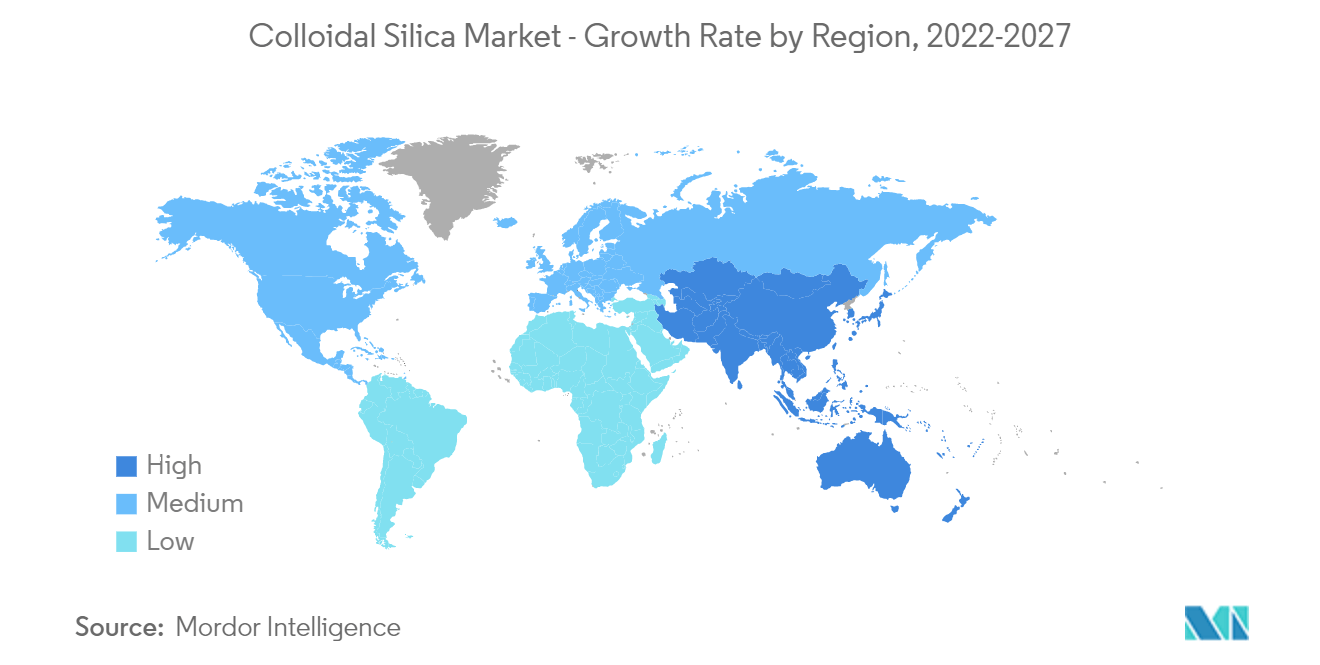Market Trends of Colloidal Silica Industry
Increasing Usage in the Construction Industry
- Colloidal silica is widely adopted in the construction industry as it enhances the strength and durability of concrete or cement. Colloidal silica is also used in floor coatings to make the surface scratch-resistant and reduce slip by increasing friction.
- Superior properties of colloidal silica such as permeability and pore water reduction and enhanced rheological properties in concrete enhance its usage in the construction sector. Increased cement hydration and resistance to chemical attacks and accelerated cement dissolution are some of the benefits of using colloidal silica in concrete.
- Increasing investments in renewable energy infrastructure coupled with decreasing cost of renewable energy and rapid technology improvements are expected to drive the construction industry. Besides, the growing demand for green buildings to lower the carbon footprints of buildings will boost the demand for cement, concrete, and other products used in the construction sector such as paints and coatings.
- The global construction output was valued at USD 10.70 trillion in 2020 and grew significantly in 2021. Moreover, the global construction output is estimated to reach USD 15.20 trillion by 2030, registering a growth of 42%, as per the report by Oxford Economics. This in turn is stimulating the demand for the colloidal silica market.
- According to the United States census bureau, the construction output was valued at USD 1,591.67 billion in 2021 as compared to USD 1,469.15 billion in 2020, registering a growth of 8.3% in the United States. Therefore, the increasing construction activities are expected to fuel the demand for the market studied in the country in the coming years.
- Owing to all these factors, the market for colloidal silica is likely to grow globally during the forecast period.

Asia-Pacific Region to Dominate the Market
- Asia -Pacific region is expected to dominate the market. In the region, China is the largest economy, in terms of GDP. China and India are among the fastest emerging economies in the world.
- Construction output in Asia-Pacific will account for USD 2.5 trillion between 2020 and 2030 and is estimated to reach USD 7.4 trillion by 2030, registering a growth of over 50%. China dominates the construction industry in the Asia-Pacific region. In 2020, the construction industry in China was valued at USD 1,049.19 billion. However, major government spending, especially focused on infrastructure has resulted in a rebounding of construction activity in 2021.
- Additionally, China's growing construction market and manufacturing activities in auto parts, oil, and gas industries will drive paints and coatings in the coming years. An increasing trend for the usage of high-tech coatings such as cationic electrocoating materials that covers all corners of metal parts for giving protection from corrosion is expected to boost the colloidal silica industry.
- India's construction industry is expected to grow due to increased demand for infrastructure projects and real estate. In the fiscal year 2021, infrastructure activities amounted to over 13% share of the total Foreign Direct Investment (FDI) inflow in the country. Besides, in the union budget 2021, the Indian government announced the allocation of USD 32.02 billion to transport infrastructure.
- The increasing trend of working from home has led to a rise in demand for computer devices and peripherals. India is a popular manufacturing hub for electronic devices in Asia-Pacific. The electronics industry in India contributed about 3.4% to the country's (Gross Domestic Product) GDP. In India, as per India Brand Equity Foundation (IBEF), the domestic manufacturing of electronic products has grown from USD 29 billion in 2014-2015 to USD 67 billion in 2020-2021. Therefore, the increasing demand for electronic devices is expected to propel the demand for the market studied in the country in the coming years.
- Rising demand for consumer electronic products such as personal computers, mobile phones, and televisions owing to the switch to online mode is expected to drive the electronics industry in coming years. Domestic manufacturing of electronics in India has grown from USD 29 billion in 2014-15 to USD 67 billion in 2020-21, with a contribution of about 3.4% to the nation's GDP (Gross Domestic Product), as per India Brand Equity Foundation (IBEF).
- Due to all such factors, the market for colloidal silica in the region is expected to have a steady growth during the forecast period.


